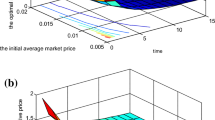Abstract
This paper is devoted to the study of an optimal investment and risk control problem for an insurer. The risky asset process and the insurance liability process are governed by stochastic differential equations with jumps and anticipative parameters. The insurer can only get access to partial information about the financial market and the insurance business to make decisions. Taking into account endogenous and exogenous factors, we assume the time horizon is uncertain. With the aim of expected logarithmic utility maximization, we adopt the forward stochastic calculus and the Malliavin calculus to derive a characterization of the optimal strategy. In some particular cases, we obtain the optimal strategies in closed-form and get some new insights.
Similar content being viewed by others
References
Blanchet-Scalliet C, El Karoui N, Jeanblanc M, Martellini L (2008) Optimal investment decisions when time-horizon is uncertain. J Math Econ 44:1100–1113
Bo L, Wang S (2017) Optimal investment and risk control for an insurer with stochastic factor. Oper Res Lett 45(3):259–265
Bo L, Liao H, Wang Y (2019) Optimal credit investment and risk control for an insurer with regime-switching. Math Financ Econ 13:147–172
Di Nunno G, Øksendal B (2009) Optimal portfolio, partial information and Malliavin calculus. Stochastics 81(3–4):303–322
Di Nunno G, Øksendal B, Proske F (2009) Malliavin Calculus for Lévy Processes with Applications to Finance. Springer, New York
Fouque JP, Papanicolaou A, Sircar R (2015) Filter and portfolio optimization with stochastic unobserved drift in asset returns. Commun Math Sci 13(4):935–953
Fouque JP, Papanicolaou A, Sircar R (2017) Perturbation analysis for investment portfolios under partial information with expert opinions. SIAM J Control Optim 55(3):1534–1566
Hakansson NH (1971) Optimal entrepreneurial decisions in a completely stochastic environment. Manage Sci 17:427–449
Hata H, Kohatsu-Higa A (2013) A market model with medium/long-term effects due to an insider. Quantitative Finance 13(3):421–437
Karatzas I, Wang H (2001) Utility maximization with discretionary stopping. SIAM J Control Optim 39:306–329
Kharroubi I, Lim T, Ngoupeyou A (2013) Mean-variance hedging on uncertain time horizon in a market with a jump. Appl Math Optim 68:413–444
Kohatsu-Higa A, Sulem A (2006) Utility maximization in an insider influenced market. Math Financ 16(1):153–179
Lakner P (1998) Optimal trading strategy for an investor: the case of partial information. Stochastic Processes and Their Applications 76:77–97
Lv S, Wu Z, Yu Z (2016) Continuous-time mean-variance portfolio selection with random horizon in an incomplete market. Automatica 69:176–180
Merton RC (1971) Optimal consumption and portfolio rules in a continuous-time model. Journal of Economic Theory 3:373–413
Nualart D, Nualart E (2018) Introduction to Malliavin Calculus. Cambridge University Press, Cambridge
Øksendal B, Sulem A (2004) Partial observation control in an anticipating environment. Russ Math Surv 59(2):355–375
Papanicolou A (2019) Backward SDEs for control with partial information. Math Financ 29(1):208–248
Peng X, Hu Y (2013) Optimal proportional reinsurance and investment under partial information. Insurance Math Econom 53:416–428
Peng X, Wang W (2016) Optimal investment and risk control for an insurer under inside information. Insurance Math Econom 69:104–116
Peng X, Chen F, Wang W (2018) Optimal investment and risk control for an insurer with partial information in an anticipating environment. Scand Actuar J 10:1–20
Peng X (2020) Expected utility maximization for an insurer with investment and risk control under inside information. Communications in statistics: theory and methods. https://doi.org/10.1080/03610926.2019.1682165
Peng X, Chen F (2021) Mean-variance asset-liability management with partial information and uncertain time horizon. Optimization 70(7):1609–1636
Richard SF (1975) Optimal consumption, portfolio and life insurance rules for an uncertain lived individual in a continuous time model. J Financ Econ 2:187–203
Xiong J, Zhou XY (2007) Mean-variance portfolio selection under partial information. SIAM J Control Optim 46:156–175
Yaari M (1965) Uncertain lifetime, life insurance, and the theory of the consumer. Rev Econ Stud 2:137–150
Yao HX, Zeng Y, Chen SM (2013) Multi-period mean-variance asset-liability management with uncontrolled cash flow and uncertain time-horizon. Econ Model 30:492–500
Yu Z (2013) Continuous-time mean-variance portfolio selection with random horizon. Appl Math Optim 68:333–359
Zou B, Cadenillas A (2014) Optimal investment and risk control policies for an insurer: Expected utility maximization. Insurance Math Econom 58:57–67
Zou B, Cadenillas A (2017) Optimal investment and liability ratio policies in a multidimensional regime switching model. Risks 5(1):1–22
Acknowledgements
The authors are very grateful to the Editor and two anonymous referees for their valuable comments and suggestions, which leads to a significant improvement of the work.
Author information
Authors and Affiliations
Corresponding author
Additional information
Publisher’s Note
Springer Nature remains neutral with regard to jurisdictional claims in published maps and institutional affiliations.
Supported by the National Natural Science Foundation of China (Nos. 11701436, 72004174) and the Fundamental Research Funds for the Central Universities (WUT: 3120621545).
Proof of Theorem 3.2
Proof of Theorem 3.2
Let \((\pi (s), \kappa (s))\) be an admissible strategy. By conditions (1) and (2) in Definition 2.1, we have
for all \(t>s\). By the product rule and the chain rule for the Malliavin derivatives, we have
and
Then by conditions (5) and (6) in Definition 2.1, Lemma 3.1, the Fubini theorem and the equalities above, we can deduce that
Moreover, by conditions (5) and (6) in Definition 2.1 and the Fubini theorem, we have
From Eq. (1) and the equalities above, we obtain that
Rights and permissions
About this article
Cite this article
Chen, F., Li, B. & Peng, X. Portfolio Selection and Risk Control for an Insurer With Uncertain Time Horizon and Partial Information in an Anticipating Environment. Methodol Comput Appl Probab 24, 635–659 (2022). https://doi.org/10.1007/s11009-022-09941-6
Received:
Revised:
Accepted:
Published:
Issue Date:
DOI: https://doi.org/10.1007/s11009-022-09941-6




